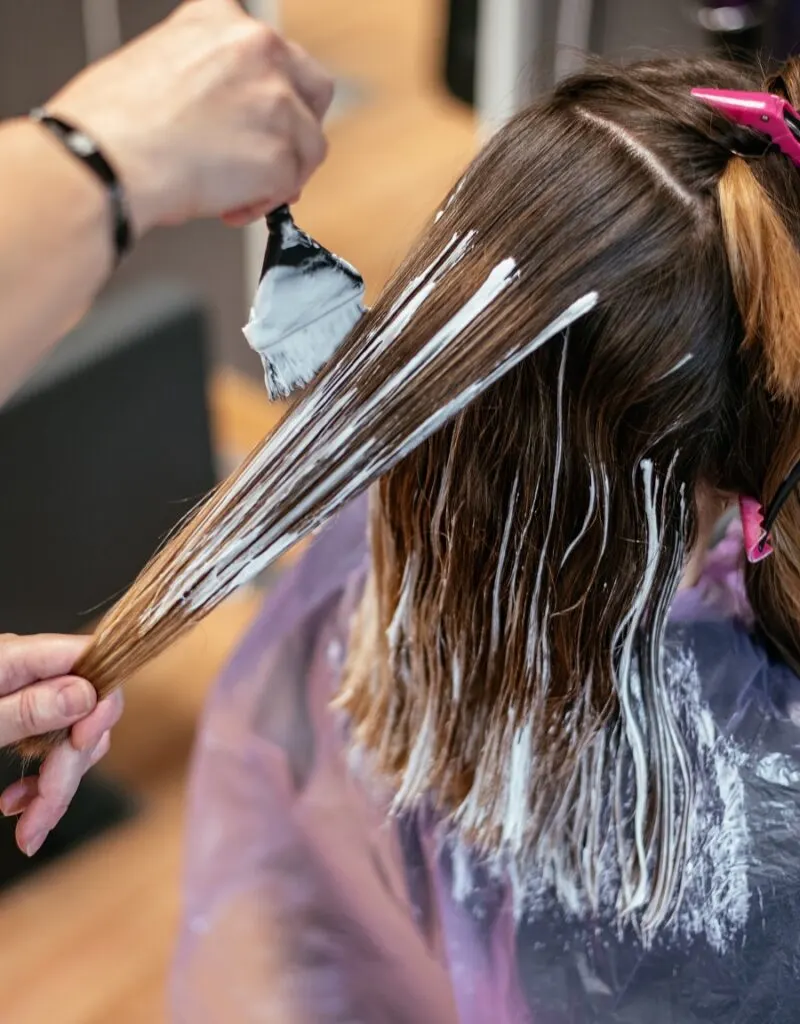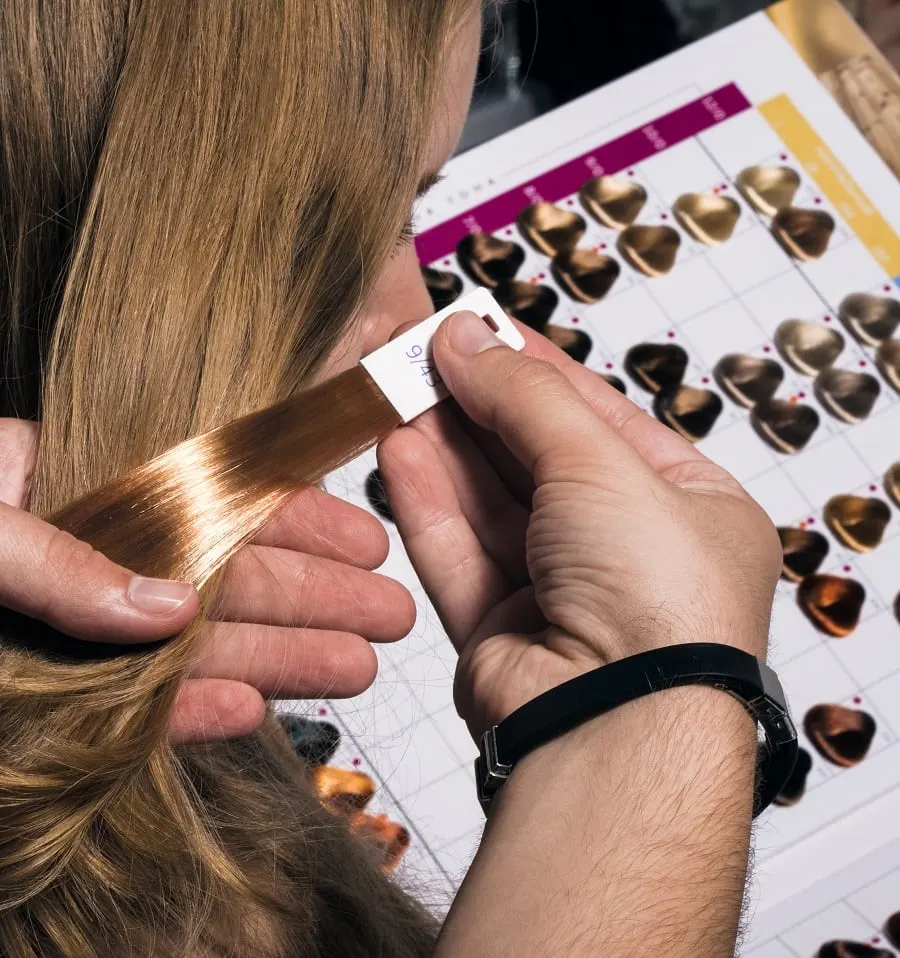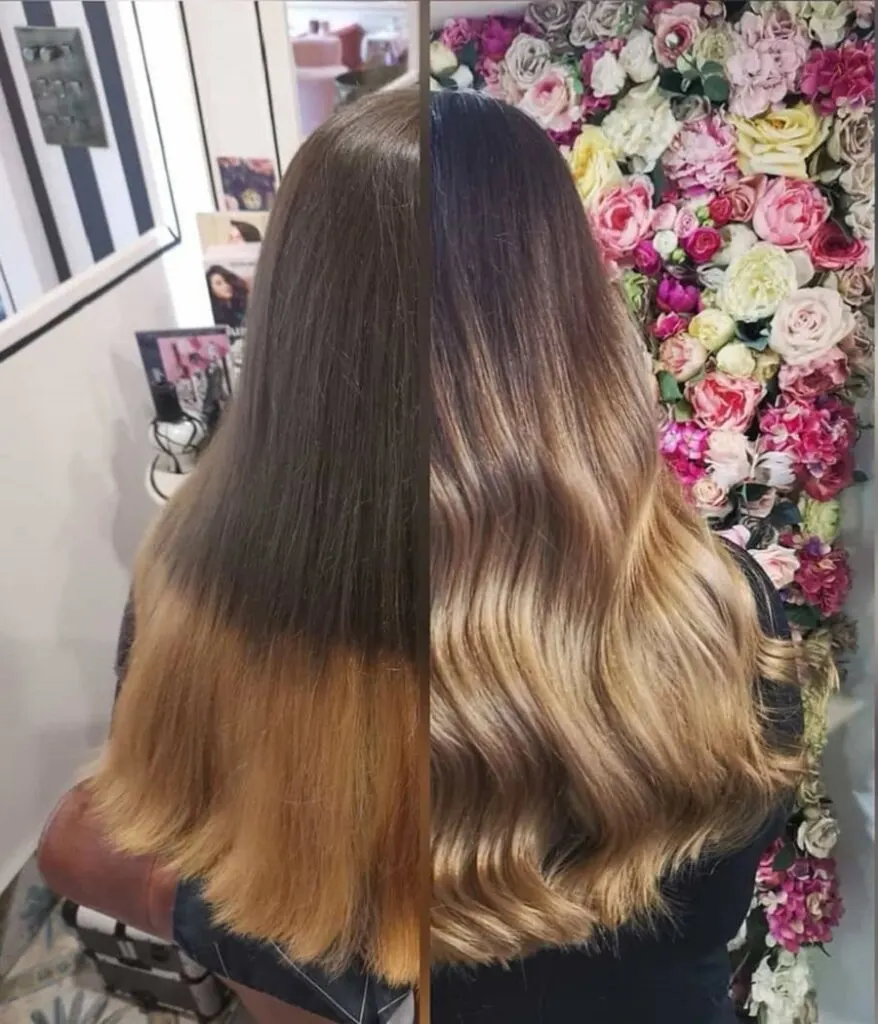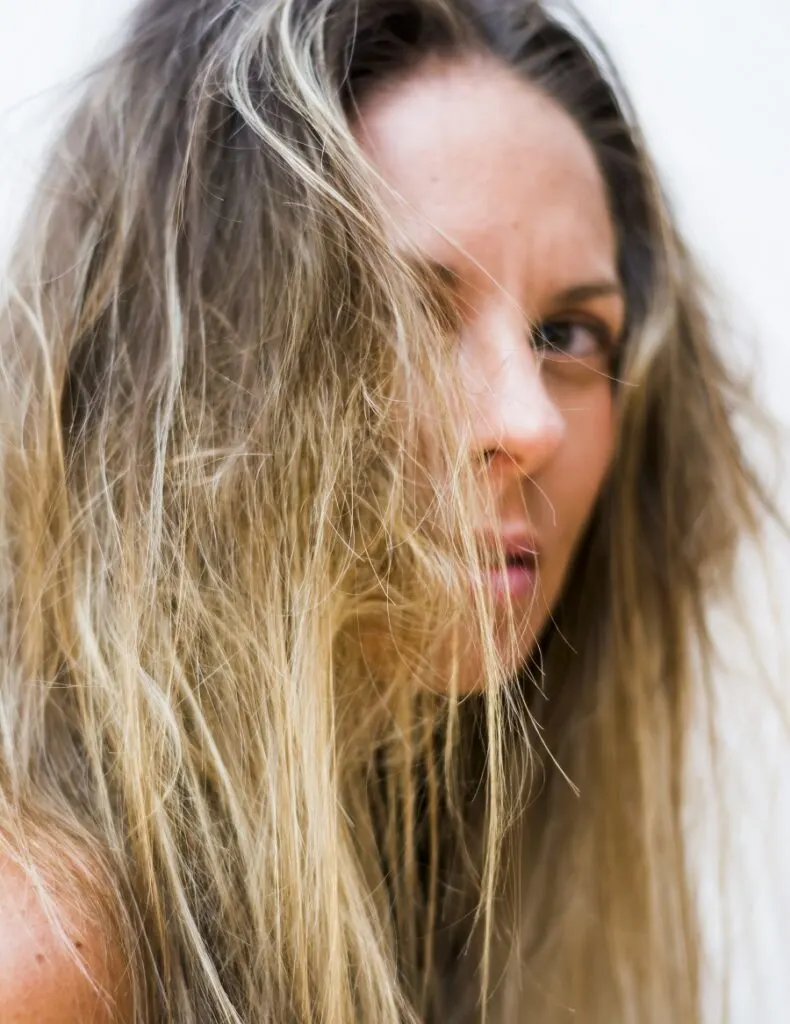When you thought about getting a balayage, you probably dreamed of getting those cool, natural-looking contrasts in your hair. But instead, you ended up with a bad balayage that looks horrible.
Now you hate your hair color and ask your stylist, “How could my balayage go so wrong? Is there any way to fix it?”
Since it is a freehand coloring technique, there are some common mistakes that can be the reason behind balayage going wrong. But you can also take proper steps to fix it.
So, if you want to know the reasons and fix your bad balayage, read this article till the end.
Causes of Bad Balayage
It’s important to know the mistakes that frequently occur during the balayage hair coloring process. If you are well-informed about these causes, you can easily communicate with your stylist to ensure they stay careful.
1. Under-Processed Painted Sections

When a stylist starts to balayage it is all about the saturation and timing. It seems like an hour is too long to let the product stay on the hair.
But you must remember that balayage-specific lightener is designed to stay on the hair longer than most color formulations.
Generally, it is enough to leave regular color on for up to 45 minutes, possibly longer for stubborn grey hair. But, you need to leave the balayage lightener on for no less than an hour.
This is one of the reasons balayage appointments take so long. Usually at busy salons, they use the processing time to fit in another client for another color or haircut.
It is hard to leave the lightener on for that long. You will be tempted to continually check it. To get a good balayage, you need to lift past the brassy stage.
Having the hour mark in your head and setting it on your timer will help you leave it to lift. If you do not lift it enough it will be difficult to tone all the brassiness out.
A visual goal can be to have the color of the lightened hair look like the inside of a banana peel. Leaving a lightener on for that long makes it imperative to use an additive to protect the hair from breakage. Olaplex is widely used for such a task.
There are other products that advertise to do the same thing such as Truss Professional 8x powder. Whichever you use make sure they have great reviews that show impressive results.
| Pro Tip: Make sure to not lighten hair that was previously dyed with a Henna color. Henna has a pigment called lawsone that attaches to the proteins of the hair. Trying to lighten henna-colored hair can result in damage to your hair. |
2. Inadequate Saturation

Another reason for getting a bad balayage is the inadequate saturation of the hair with the lightening product.
This is a very common issue for new hairstylists. Proper saturation is the perfect balance of not too much but not too little product on the hair.
Here are some tips for proper saturation:
- Always start the application in the middle of the section you are painting.
- When you are painting close to the top, you want your saturation to be even but only on the surface of the section you are painting.
- Feather up towards the roots for a gradient transition
- As you apply the product towards the ends then you will want to build a heavier saturation.
- There should be zero transparency and complete whiteness from the lightener on the ends.
- Make sure that the sections underneath the painted hair stay untouched from the product to maintain depth.
3. Neglecting Consultation
This is a frequent reason for botched balayage. Not to get into the psyche of every stylist but it is important to have an in-depth consultation with your stylist.
Your hair grows half an inch in a month. So, if you have twelve inches of hair, the ends still have the color or treatment you did a year ago.
You could have been blonde and then went back to your natural color. That means you still have chemicals on the strand of that hair.
If your stylist knows about the treatments or hair colors you have used in the recent past, they can keep your hair’s integrity intact while giving you the desired result.
Water will also coat the hair and interfere with lifting to the proper lightness. The hair will have a rough texture if it has water build-up.
Most of the time the hair will have a brassy color to it. Chlorine will also create a film on the hair and in some cases have a green hue to the hair.
| Pro Tip: Do a treatment to take out the minerals in the hair before you try to lighten it. Malibu systems are a frequent choice to take out water residue and chlorine. |
Information you should provide to your balayage stylist:
- When was the last time your hair had any color at home or at the salon?
- Has your hair been in contact with well water? When and for how long?
- Has your hair been in contact with chlorine? When and for how long?
- Are you on any medications? Especially, hormone medication?
- Thyroid medication and certain antibiotics can affect the coloring of the hair
- It is best to use a picture to make sure the stylist and the client are on the same page.
4. Using the Wrong Brush
When the balayage technique came to the States, stylists continued to use the tools that they used for traditional foils. And this is the most common mistake that causes bad balayage.
To paint like an artist, your stylist needs brushes that an artist would use. The stiff brushes that the hair industry produces in the masses are too stiff.
Balayage technique is to make sweeping motions. Depending on the type of hair, whether it is coarse or fine, straight or curly will determine which brush your stylist going to choose.
There are certain aspects of a brush that you want to ensure are present in the one they choose.
- Bristles should be soft with tapered edges to be able to apply color with precision and accuracy.
- Bristles being feathered help with the diffusion of the product near the top
- It is important to be able to put adequate product on the brush without straining the stylist’s wrist.
- Angled brushes are great for fine, delicate pieces and are ideal for specific color placement.
- Paint brushes with more bristles than usual and tapered are great to use on coarse hair.
| Pro Tip: Boards are a great tool to use with brushes. They ensure the correct saturation of product on the hair. |
5. Choosing Wrong Color

Selecting a color that is much different from your natural hair shade can lead to a bad balayage. This error can make the hair appear mismatched and can even affect how your skin tone appears.
If you show your stylist a picture of the balayage make sure it will complement your natural hues well.
It’s best to pick a color that is just a few shades lighter or darker than your original hair color to get a natural and appealing balayage.
This way, the highlights blend well with your base color, giving a smooth, sun-kissed effect instead of a harsh contrast.
These are the common reasons for bad balayage. There are also other maintenance-related issues like washing hair too soon after balayage, using sulfate shampoo and conditioner, excess sun exposure to hair, etc., that may lead to uneven balayage results.
How to Fix Balayage That Gone Wrong

What to do if you have made some mistake and the balayage has already gone wrong? You can fix it too! Here are your possible fixes:
1. Toning
The easiest way to fix a bad balayage hair color is by applying a toner. Depending on the balayage color and undertone, you can use toning shampoo or a toner.
The level of your hair toner depends on the lightness of the highlighted sections. For instance, if your highlight is a light blonde and is uneven, put a level 9 or darker shade on it.
And if you prefer your highlights to have a warm or cool look, you can use a gold or violet toner, respectively.
If your balayage is too brassy, your toner either needs to be an ashy toner or a violet toner. Ashy or green toners will counteract more red-to-orange undertones.
Violet toners will counteract lighter orange undertones. Natural brunettes can use purple toning shampoo on balayage to fix brassiness.
2. Re-Applying Lightener
Sometimes the best fix is to start over. In this case, you’d selectively reapply the lightener to the sections of hair with uneven balayage.
This step is necessary if the balayage has turned too orange to be corrected with toner alone. The goal is to lighten it beyond the orange stage. Then you can tone it to get a nice even balayage.
3. Apply a Semi-permanent Hair Color
When would you apply a semi-permanent hair color? It’s an excellent solution if you’re dealing with bleeding spots.
This happens when the lightener accidentally comes into contact with sections of hair that weren’t meant to be lightened, resulting in unwanted patterns that can resemble tiger stripes or uneven spots.
By applying a semi-permanent color, you can mask the areas affected by the lightener, as it will blend with the base color.
You will want to put this in a protective barrier of foil so that the semi-permanent hair color does not get on the balayage pieces.
Sometimes you will need to combine reapplying the lightener with applying a semipermanent to the base, especially if you are tackling issues like brassiness and uneven spots.
Always finish with a toner to blend processes. If you don’t want to darken the highlighted parts, use a level 10 Demi-permanent as your toner shade.
How to Get the Best Balayage Results

Now you know the reasons that caused your balayage to go wrong and how to fix them. But if you want to have perfect balayage that lasts longer, you have to remember bad balayage can be caused by the client’s or the stylist’s mistake.
For example, the client may not be able to provide the proper information required for the desired result, or stylists might misjudge the hair type or use the wrong brush.
Here are some tips for hairstylists and clients to achieve a good result.
As A Stylist
The best way to achieve a perfect balayage is knowledge and experience. There are many educational videos and classes on the subject of balayage. Take in as much as you can.
These stylists have gone through trial and error in using different products, tools, and techniques. Learn from their experience to avoid the pitfalls that balayage can have.
Use an actual lightener so you can see how the lightener works with the technique you use. Schools use manikins’ heads with real hair for a reason. They are great for trying out new techniques and tools. You can learn from the mistakes on the manikin and not have to worry about repercussions.
If you are in a salon setting, watch and learn from senior staff. If there is someone known for their remarkable results in balayage, study their technique.
Do not let pride prevent you from achieving the perfect balayage. For the stylist, you can become the top in your trade with knowledge and training.
Before you start the actual process of balayage have a detailed consultation with the client to understand their expectations and to give appropriate suggestions based on their hair type and condition
As A Client
If you want to avoid a bad balayage, consider factors like your skin’s undertone and eye color while choosing the shade of your balayage. Generally, staying within two to three shades of your natural color gives a flattering result.
For instance, if you have medium brown hair, adding soft caramel highlights might be a great choice. Natural balayage colors like blonde, ash blonde, or red are suitable for all skin tones and hair colors.
When doing a balayage if your stylist is lifting a previous color know that it will take multiple visits to get many levels lighter. It depends on the condition and darkness of the hair.
Your responsibility is to inform the stylist about any hair treatment or hair color you have used within a year. For those looking for a stylist who is trained to do balayage, look at their portfolio and reviews.
Balayage can be scary with the mistakes we have gone over. But you are now more prepared than you were yesterday.
So, now you can try out balayage more confidently because you know how to fix and prevent bad balayage and ensure a perfect result, whether you are the stylist or the client.
